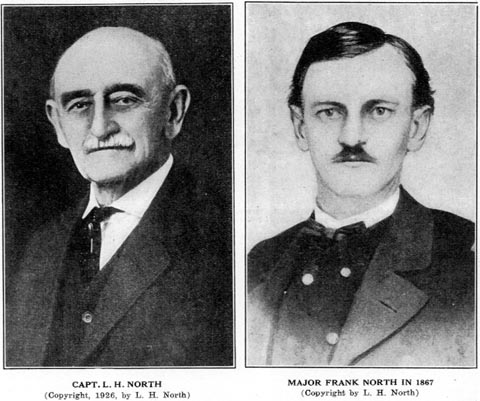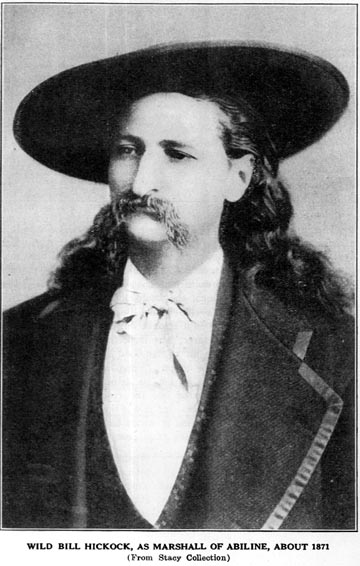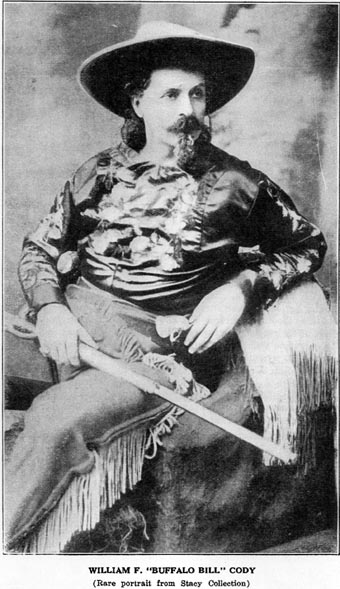|
12 |
|
Vol. XXV, No. 3 |
The Truth About "Wild Bill"
By Herbert Cody Blake
(Copyright 1927. All Rights Reserved.)
![]() OR
over 50 years, histories, magazines, newspapers, and the like have
credited "Wild Bill" Hickok with being the greatest, deadliest,
quickest, and surest shot with a revolver of the West. One
book, a beautiful rehash of all the old dope, speaks of him as the
"Prince of Pistoleers." I ask, where do these "historians" and
roll-top desk fakir frontiersmen get their dope? Is there among
them one who knew Wild Bill? Or ever saw him?
OR
over 50 years, histories, magazines, newspapers, and the like have
credited "Wild Bill" Hickok with being the greatest, deadliest,
quickest, and surest shot with a revolver of the West. One
book, a beautiful rehash of all the old dope, speaks of him as the
"Prince of Pistoleers." I ask, where do these "historians" and
roll-top desk fakir frontiersmen get their dope? Is there among
them one who knew Wild Bill? Or ever saw him?
Have they any facts obtained first handed? For over 50 years the old stuff has been rehashed, warmed over and over, and "histed" at the public.
It's about time the truth was told, not only about Wild Bill, but about Bill Cody (Buffalo Bill), Custer, California Joe, and others, especially some of a more recent vintage--Bat Masterson, for example.
I never knew Wild Bill. I do know men who did--men who were intimately acquainted with him, who rode, ate, drank, smoked, gambled and bunked with him, and what's of more interest, shot with him, and I offer the following as proof that he was not the expert with a .45 he is credited with being.
Bill Cody seldom told the truth,
"Sitting Bull" overreached him, but Cody had Ananias, Theresa
Humbert, and Dr. Cook tied, his claim of having killed "Tall
Bull," "Yellow Hand." etcetra, being illustrations. Cody did tell
the truth when in answer to the question, "Was Wild Bill a crack
shot?" he replied, "No! Just fair, just fair."

The majority of the readers of THE AMERICAN RIFLEMAN are familiar enough with firearms to appreciate the following incidents, which not only throw light on the much-discussed, ability of Wild Bill, but line up one or more noted Westerners in their proper places in the parade. Wild Bill was one of the quickest revolver shots in his time. He was not the best--perhaps not the quickest, and positively not the quickest at a mark. It's a question if he was as "sudden," for example, as Sheriff Johnny Owens. Shooting at a mark, at a target, for a bullseye, Bill was slow, painfully slow, and absolutely a poor shot.
Which bluff, having made it, I will upholster with facts.
Capt. Luther H. North, 81 years old, a highly honored resident of Columbus, Nebr., brother of Maj. Frank North, the organizer and commander of the famous U. S. Army Pawnee Scouts, 1865'-77, was intimately acquainted with Wild Bill, Bill Cody, and other celebrities of those days. Captain North is noted for a wonderful memory. He was a great rifle shot. Two--and only two--men ever wiped him off the board--Lieut. Bill Harvey of the Pawnee Scouts, and "Little Buckshot" Wentworth. Mrs. North, who in her youth was a celebrated "hoss woman" and crack rifle shot, is the only woman who ever beat him. Captain North tells me:
"Wild Bill was a poor shot when firing at a target with a revolver. It was in 1873 that
|
March, 1927 |
|
13 |
I was in Cheyenne and saw my brother, Frank, John Talbot, and Wild Bill at target practice. The distance was 100 feet. Frank won, Talbot was second, and Bill a rather poor third; and I will say now that if Bill was fast on the draw, or could shoot from the hip, he certainly didn't show it that day. "He was very deliberate, and in aiming closed his left eye. As to his being a two-handed gunman, Frank said so long as he had known Bill he had never seen him use his left hand. Talbot was a noted pistol shot, and he said Frank was the only man whom he had met who could beat him. "Frank frequently beat Bill shooting at 50, 75, and 100 feet. Bill and Frank closed the left eye, Talbot kept both open." Johnny Owens was not only as quick pulling and "pinting" a six-gun, but he was a much better shot than Hickok. Many of the older readers of THE AMERICAN RIFLEMAN will recall to memory the name "Belden" (White Chief), and as it has never been told in print, I'm going to digress long enough to repeat a story told me by Captain North about Belden and Bill Cody, and give it as near as I can as told me by the old scout.
"You ask me if Bill Cody was a crack shot? Well, on a running hoss with a rifle Bill was the best shot I knew. On the ground? Say, did you ever know Belden? He and I were buck soldiers in the Second Nebraska Cavalry during the Civil War, high privates in the rear file. He afterwards became a lieutenant in the Regular Army, but I don't know what regiment.
"Like as not you read in Bill's
autobiography where he and Belden shot a match. That match was the
'limit'. They were both half stewed when they started, and after
each shot at the target they would adjourn to the sutler's store
(it was at Fort McPherson) and


take a drink or two. The target was a piece of white paper tacked
on a soap box about two feet square (the box), and about half the
time they missed the box--to say nothing about the paper-shooting
at 50 yards, not 100 or 200, as Bill says. Belden beat him. "I
ain't holding that exhibition up as a fair sample of either his or
Belden's skill, for they neither of them could see the box after
few shots.
"We were in the cattle business in the '70's, after we quit 'Injuns,' with Cody for a partner. One day, up on our ranch on the North Platte, Bill and me were out back of the ranch house shooting our Winchesters (1873 model .44 caliber, '8-squar' magazine). We stuck up a 'tomatter' can and fired at it 50 yards off. 'Was we sober?' you ask--absolutely.
"It wasn't like the days round Fort McPherson. As I was observing, 50 yards off, and Bill was missing it. Frank came out of the house and let go all six shots (.44's) in his revolver and plugged the can five times out of the six. He used, at the time, one of the pair of S. & W. Russian Model .44's presented to him by Professor Marsh of Yale--pistols like you and I have now.
"Cody walked off, and chucking his rifle up onto the dirt roof of the ranch house, remarked, 'I guess I won't shoot any more today.'
|
March, 1927 |
|
35 |
The Truth About Wild Bill
(Continued from page 13)
"As for revolver shooting, I couldn't beat Cody, yet neither of us could hit a barn, and if I wanted to hit the house I'd have to go inside and shut the door. The time I beat Bill Burke, John Hancock, and Bill Burroughs, and half a dozen more up at North Platte, my string for ten shots was 12 1/4 inches at 50 yards off-hand. When Cody won from "Yank' Adams at Portland, Me., his string was only 21 1/2, same conditions. Both matches were with rifles." * * *
Having mentioned Custer and California Joe, a word regarding them may interest readers. A volume could be written--and is in preparation--giving the real "dope" regarding California Joe. He was one of the greatest shots of the West. Custer was a fair shot--that's all. Like Cody, he loved the limelight, courted notoriety, was fond of overdressing and getting credit for what the other fellow did. Custer's favorite photo, holding the "8-squar" Remington so-called sharpshooter's rifle, .50 caliber, as he sat alongside that big buck (which he did not shoot), shows it.
To get back onto the trail--Why could Wild Bill shoot so quickly? It's as plain as paint--and any one interested can demonstrate it. Hickok lived every minute in suspense. He expected trouble; never relaxed; never became careless--until Aug. 2, '76, when he sat with his back to the door. Always in anticipation of trouble, he was ever ready for it.
Mr. Robert ("Baldy") Johnson knew Wild Bill intimately, and remarking how cautious Bill was, says:
"Hickok, entering a room or saloon, would never walk straight across it. He would ease himself along the walls, would go in front of the bar in a saloon if it had a mirror, but otherwise would go to the end of the bar where no one could get behind him. He was always alert, although apparently at ease."
He did not, as has been claimed, shoot on a line with his eyes. Had he done so he would have been put on file early in his career. As Captain North, Talbot, Mayhew, and others testify, he was painfully slow and deliberate aiming at a mark and shooting at a target, a poor shot, usually finishing at the bottom of the list. The 10-cent-piece story is manufactured bunk--he never fired at one.
It is denied by those who knew him that he packed a spring shoulder holster--more bunk. Regarding the two revolvers he wore at the time of his death, Utter (Colorado Charlie), his pal, retained one and gave the other to California Joe, the great scout and "Injun" fighter. Joe was a real shot, and could have cleaned up Bill or any of the others of that day and generation. Joe was soon afterwards murdered in the same cowardly fashion (shot from behind) as Wild Bill, and the probability is had with him at the time Wild Bill's revolver. The whereabouts of either of these Colts is unknown to me.
One Colt, an ivory-handled .44, which Bill packed back in 1870, had the front sight filed off. Regarding where and how Wild Bill wore his guns, very little of what we read is true. He had both pistols and holsters given him by the score, and he gave away the majority. One account, published in 1882, tells how Bill wore a Texas holster, tied down to his right leg, and places the time 1872.
It rather lets the whey out of that statement to look over the photos taken of Bill, alone or in groups, with Utter, Omohundro, Cody, and others, for in a number of them his pistols were stuck in the top of his trousers, for cross drawing (butts towards center). These photos were taken between 1870 and 1876.
Try the following experiment if you are interested in demonstrating "quick draw."
Belt on a single action .44, loose, tied down, or tight, on right side or cross draw. Have a friend time you. Draw, raise, cock, lower, aim and fire at a target, size and shape of a man, not over 20 feet away. Aim or not. For the sake of argument don't aim. Fire to hit the target. Then take and weaken the mainspring. File it down (most mainsprings are too stiff). Ease the pull till it is a hair-trigger. Pack the gun in a real, genuine, quickdraw holster. Belt it on. When you draw this time, let it be done by pulling the gun out of holster with the thumb on the hammer and forefinger inside the guard, cocking the gun as it comes up, grasping the grips as it clears. Fire on the rise. No up and then lower. No cocking after drawing. Practice this a week, first. Use blanks or, better yet, exploded shells, unless you care to get new pants-maybe legs or feet. Notice the time. Note the difference. Let your friend use the first method, you use Wild Bill's, and see the difference. He needed no sights, but he did not, as we read, shoot from the hip, nor do any snap shooting or fanning. He did not aim, as we understand aiming. It was as if you point your finger. He had no bull's-eye on his targets! Seldom, very seldom, were his victims over 20 feet away. He had fired before one could aim. Hickok's great secret was in being ready. An old sport, years ago, writing about Wild Bill, tells us he took "touch me not" for his slogan, and after the fashion of his time translated it liberally--"If you see anybody looking for trouble, accommodate them." Wild Bill. not only accommodated such, but looked for them.
"Do unto others what they'd do to you, but do it first," was his rule. The secret of a successful quick-draw holster is that it be possible, if held in the hand, to fire the gun without removing it. With practice the average reader can, with a single (not double) action 5 1/2-inch .44 or .45 Colt (with the front sight knocked off), in a Weaver quick-draw holster, become as sudden as were Wild Bill, Hardin, Owens, and the others.
Our thanks to Linda, who found this old article!